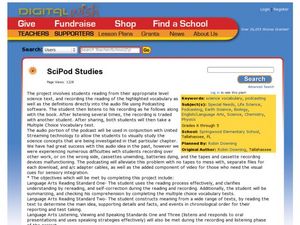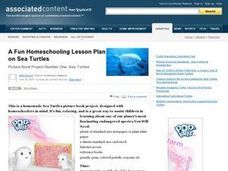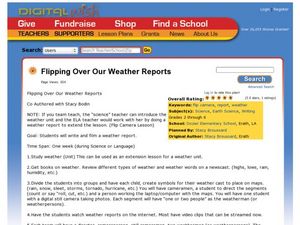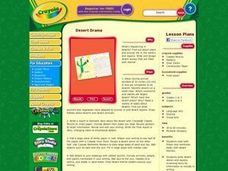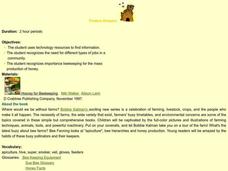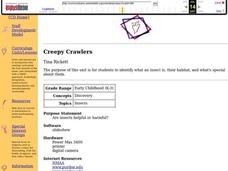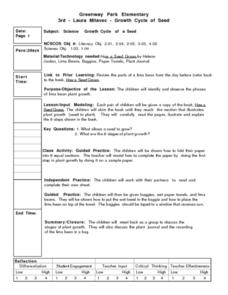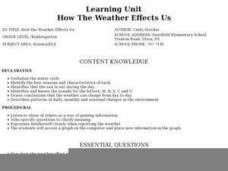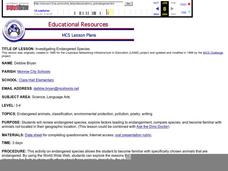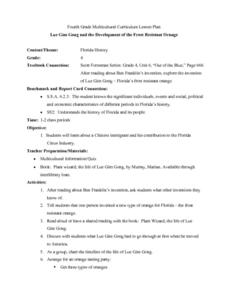Monroe City Schools
Clouds! Clouds! Clouds!
Here is a beautiful lesson on clouds designed for your 1st graders. Learners study three different types of clouds. They construct drawings of cumulus, cirrus, and stratus clouds. The Cloud Book, by Tommie dePaola is used to...
Curated OER
Habitat Assessment
Third graders demonstrate the effects of varying environmental components on plants and animals: chemical, physical and biological characteristics of a habitat. They find chemical, physical and biological characteristics of the lake at...
Curated OER
SciPod Studies
Have fun preparing a science podcast. After reviewing vocabulary, learners record audio files to create science vocabulary podcasts for particular units of study. A clever way to incorporate technology.
Curated OER
Homeschooling Lesson: Sea Turtles
Pupils write down the names of common turtles and observe pictures of various types. For this sea turtles lesson, students review names and features of these animals, label and draw a picture. Pupils research habitat, migration,...
Curated OER
Flipping Over Our Weather Reports
Students create their own weather report. In this weather lesson, students work in groups to predict the weather for three days and create their own video. They have a director, camera-person, still cameraman, and two weathermen.
Curated OER
Desert Drama
Students read both fiction and nonfiction books with desert themes. Then they write desert stories and reports, reviewing texts for information to include in writing. Students also design desert scenes with details and setting elements...
Curated OER
Machines: Useful But Dangerous
First graders study, observe, and use a simple machine. They study necessary safety and review posted safety rules related to using a machine and identify strategies for reporting any accidents or injuries.
Curated OER
What is a Robot?
Young scholars explore robots. In this robot instructional activity, students discuss what they know about robots and what kinds of jobs they have seen robots do. Young scholars research robot books, chart their findings and share with...
Curated OER
Finders Keepers
Young scholars explore the career of beekeeping. In this careers instructional activity, students examine the importance of the beekeeping industry. Young scholars read stories about beekeepers and write comparisons. Students write a...
Curated OER
A Tree is a Friend
Fifth graders discover the value of trees in our society. In this ecosystem instructional activity, 5th graders read the book, A Tree is Nice, and discuss with classmates how trees are essential to our existence due to creating...
Curated OER
Know It All: Seals! Teaching Plan
Students discover information about seals, including behavior and habitat. In this early childhood lesson plan, students identify various aspects about seals. Students create an illustration or painting of their favorite seal, and...
Curated OER
Creepy Crawlers
Students identify the characteristics of an insect and their habitat. They read books about insects, research different types of insects, and create their own insect art. The project also includes the creation of an insect song and...
Curated OER
How do pollutants bioaccumulate and biomagnify?
Students review the basic concepts of the food chain. In small groups, they research an organism and create a food web. In addition, they study biomagnifications and write a brief essay or make a poster informing others about the...
Curated OER
The Lima Bean
Third graders investigate the life cycle of a seed. The parts of a lima bean are presented as part of a review. They identify the parts of the seed and state different stages as seen in observation. Students also use an illustration to...
Curated OER
Cricket Times
Young scholars design a class newspaper all about their study of crickets, including illustrations and various sections of the newspaper, like sports, jokes, articles, food, and reviews. Students create a plan to design a cricket from...
Curated OER
Smoses Toy Expo
Students research one of the simple machines listed in the lesson and review several simple machine websites to complete their research. Students use software and a watch a video to learn more about machines. Students create a poster...
Curated OER
How The Weather Effects Us
Students discover how weather affects their lives. They review the climates of Florida, Alaska and New York. They need choose the place they would most like to live in based on the climate of that state.
Curated OER
The Insect Files
Pupils are provided with a physical description of the insect, in words and graphics, including body parts, special adaptations, color, and so on. They explore and report on all four elements of an insect's habitat: food, water, shelter,...
Curated OER
Element Project
Ninth graders review and discuss the Periodic table and its 53 elements. They choose one element to become an expert on and then create a written Report in the form of a poster about their choosen element to be presented to the class.
Curated OER
Investigating Endangered Species
Students pick an endangered animal to research and report their findings to the class.
Curated OER
Genetic Disorders
Seventh graders discuss traits, traits that are inherited and how genes and chromosomes carry the code for traits. They research genetic disorders and their link to chromosome abnormalites and write a report on their findings. which...
Curated OER
Lue Gim Gong and the Development of the Frost Resistant Orange
Fourth graders read about Ben Franklin's invention and talk about other inventions they have heard about. They listen to the book about Lue Gim Gong and discuss what he had to go through at first when he came to America and chart the...
Curated OER
Spider Webs
Learners create spider webs. In this spider webs lesson, students research various types of spider webs then write a report about a spider of their choice. Learners also make their own web similar to an orb spider.
Curated OER
Butterflies, Butterflies, Butterflies
Transform your class into a butterfly museum! Research different types of butterflies, their habitat, and life cycle. Interactive components such as PowerPoint presentations, Claymation movies, and webpages add pizzaz to the museum...


